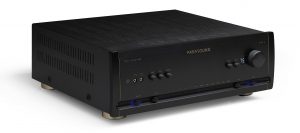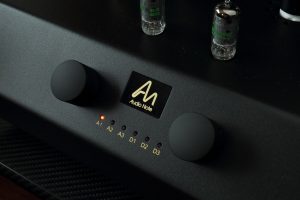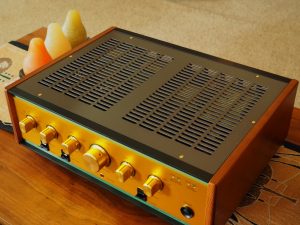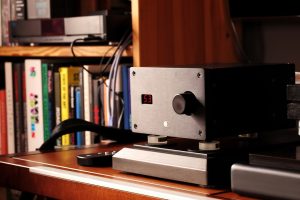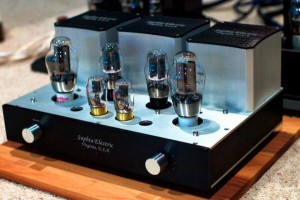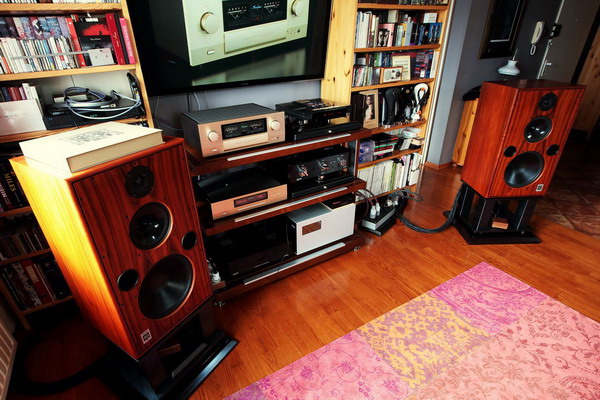
While tracing the development of the Accuphase company for the last several years, I underestimated its approach to designing audio equipment for a long time, which was in evident contrast with my respect for the products themselves. They have always been and undoubtedly will continue to be a model as regards the quality of workmanship, design, engineering efficiency and reliability. Looking at them and at the way they are built is a real pleasure. That is surely why second-hand devices bearing the Accuphase logo are highly priced and still in demand. Another important factor is the lifetime of these devices. They rarely break down due to high quality of construction, good workmanship and the components used.
The dissonance between my impression of the way the company operates and its products was based on my distrust of those who rely on measurable parameters and place them on a pedestal. In the 1970s, almost the whole industry worked in this way. Only the renaissance of tubes with their very strong sound distortion made it necessary to revaluate the performance of audio firms. As a result, another change in sound quality was enforced, which was a significant step forward. It all related to one simple fact: the great majority of devices built only on the basis of selected measurements (arbitrarily selected and interpreted, also when it comes to their correlation), produced ‘colorless', dead, plain and empty sound. Such equipment was contrasted with tube audio devices characterized by soft, natural, full sound in which it was possible to "feel" flesh-and-blood people.
A few decades later we are somewhere else, in a significantly different situation. As far as both types of signal amplification are concerned, it is surprising in this context that one thing proved helpful in both cases: reliable, creative, productive engineering. What people had already known, but had not been able to interpret correctly, was now proved to be true: good measurable parameters really help to obtain good sound. Sometimes some part of them can be "sacrificed", but never everything. The key was, however, to take a different approach to measurements and to correlate them with sound quality tests.
Thanks to this approach, power supply, mechanical construction, as well as EMI and RF radiation protection in devices was significantly improved. The signal to noise ratio and the damping factor were also increased, whereas distortion was decreased. However, it was done in a different way than before. In the 1970s and 1980s feedback was simply increased, which ruined the sound. It is now known it is possible to make feedback systems really "helpful"—it is so in Swiss Soulution, American Boulder and Japanese Accuphase amplifiers. However, one must know how to do it and it is necessary to be careful with depth. Decreasing noise in Accuphase products, including the E-470, consists of shortening the path, eliminating unnecessary contacts and improving power supply. An important role is also performed by the improved AAVA system volume control, a complex system replacing a potentiometer or an integrated circuit, dampers used by other manufacturers.
That is why, looking now at the information sent to us by the manufacturer, specifying all the changes that have been introduced since the previous model—the E-460—was launched, I understand what the E-470 does and I can hear what the effects are. However, a lot of time must have passed for these modifications to improve the sound directly in its key aspects, among which depth, fullness, fluidity and differentiation are most important.
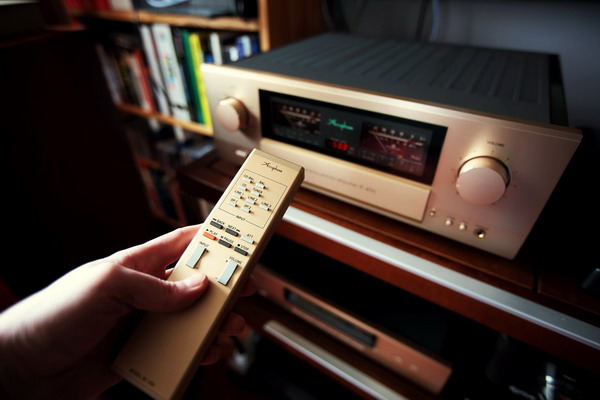
Alongside with the integrated E-470 amplifier I also asked for another novelty—the brand new digital-to-analog converter DC-37—the first such converter in Europe and sixth in the world. It seemed to me to be a natural partner for the E-470. Although I thought it was the first DAC launched by Accuphase for which there is no dedicated CD or SACD transport, Mr. Suzuki (see the text below) reminded me that, in fact, Accuphase once launched a standalone DAC, the DC-61, in 1996. All the remaining DACs were part of a top digital source consisting of transport and a D/A converter.
This time we get a standalone DAC. Apart from classic inputs and an HS-LINK input, it also has a USB port—the most important one in our times, I suppose. It is supported by the Bravo SA9227 system and allows to send PCM signal up to 32-bit and 384kHz (i.e. DXD signal), as well as DSD64 and DSD128 signal to the converter. Using a nice-looking display, it shows the sampling frequency and, additionally, the number of bits, which is unique. It has an adjustable output level, in the digital domain, so it can be connected directly to a power amp. However, in my system it operated as a pure DAC. I used the Siltech Golden Eagle 75 Double Crown cable to transfer signal from the CD transport and the power supply Crystal Cable Golden Dream cable. Signal was transferred from the computer using the USB Acoustic Revive USB-5.0SPS cable.
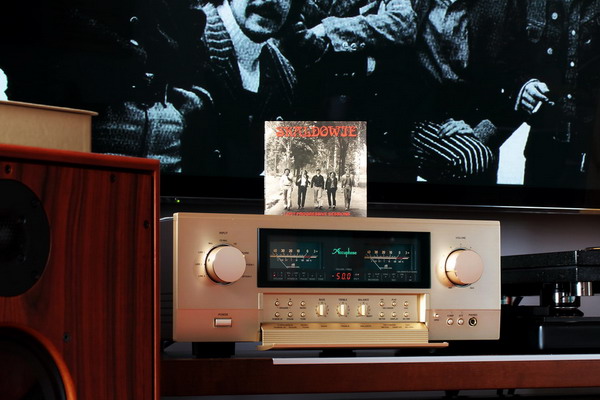
However, before you start your listening sessions with any Accuphase amplifier, it is necessary to devote some time to it. Such outstanding measurable parameters as those achieved in new Accuphase devices are based on the operation of components at a stable temperature, after capacitor formation and after the connections at solder joints and the mechanical structure of the power transformer are established, etc. It means that a new amplifier will not play music as well as one which has been operating for some time already. The process, called "warming up", is always necessary, but here particularly important.
New Accuphase products should be used for two, three weeks before any listening sessions are held—and this is not everything. No matter if our heart is green or not, we must consider the fact that amplifiers, including the E-470, should be turned on for a few hours before a listening session. It is not necessary for them to play music—they just have to be connected to a power supply. Actually, they should never be switched off. Fortunately, we are talking about AB class here, without input signal, so energy consumption is reduced to a minimum. Moreover, it is really worthwhile—the effects will make us forget the world.
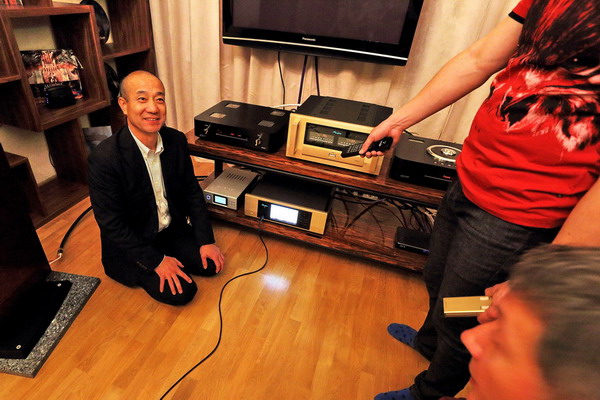
A few simple words with…
MARK M. SUZUKI
Accuphase | Executive Vice President
WOJCIECH PACUŁA: Who designed the E-470 and the DC-37?
MARK M. SUZUKI: The engineers from our Design Department designed them. We set up a project team for every model. The E-470 team consists of four engineers, whereas the DC-37 team comprises three engineers.
What goal was set for the engineers who were working on the E-470?
The goal was simple: while designing the E-470 we aimed to implement technologies which we had developed for our top products prepared on the occasion of the company's 40th anniversary: the C-3800 preamplifier and the A-200 power amplifier. The most important technical highlights of the E-470 include "Ultra Low Noise" and the "Super High Damping-factor".
Why did you decide to launch the very first standalone DAC (without transport) in your company's history?
In fact, it is not our first product of this type, as we already launched the DC-61 processor in 1996. However, unfortunately, the DC-61 was not very successful. I thought it was our top achievement.
(more information: HERE).
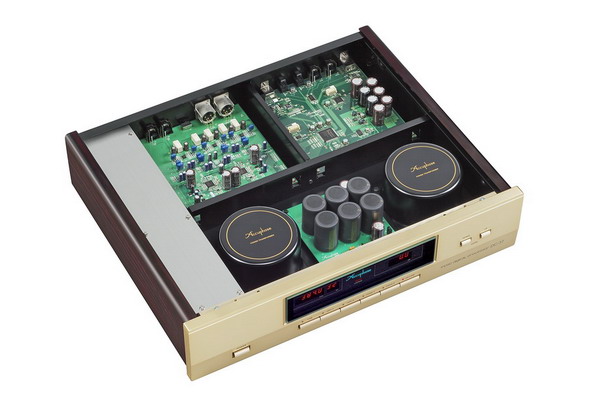
Nowadays we can get high-resolution music (384kHz/32bit-PCM, 5.6MHz-DSD, etc.) and we simply want to listen to it. Therefore, the time has come for a standalone DAC that will make it possible for us.
Moreover, the DAC section of the DC-37 has the same configuration and scale as our flagship integrated SA-CD/CD player: the DP-720. If you are using a player such as the DP-550 or an older model, you can improve its sound by connecting it to the DC-37.
How can the "Damping factor" or the S/N ratio be improved further? Is it at all possible in this type of a product?
Improving these parameters is very difficult, but it is not impossible. We are constantly working on new technologies. I cannot talk about them yet, but you will see them in our new products.
Are you going to launch a headphone amplifier? How about a turntable? You have already launched cartridges and a phono stage…
We have no idea for a standalone headphone amplifier. It is mainly because our preamplifiers and integrated amplifiers have very good in-built headphone amplifiers.
When it comes to a turntable, the answer is: no! There is no such option. We specialize in electronic components and do not want to deal with the mechanical side of things at all!
What are the benefits (sonically) of AB class and A class amplifiers?
It is very difficult to say, because the feeling of sound depends on the individual.
The photos were taken during the visit of Accuphase managers in Cracow on 16th October 2014, at a meeting of the Krakow Sonic Society
ACCUPHASE in High Fidelity
Other
- KRAKOW SONIC SOCIETY, meeting #95: Accuphase DG-58 |
- Jim S. Saito, Mark M. Suzuki, Tatsuki Tozuka, Kohei Nishigawa in Cracow, read HERE
- INTERVIEW: Jim S. Saito, Yasumasa Ishizuka, Tatsuki Tozuka, read HERE
- HYDE PARK: Accuphase – wczoraj, dziś i na zawsze (Accuphase – yesterday, today and forever), read HERE
Integrated amplifiers:
- TEST: Accuphase E-600 – integrated amplifier, read HERE
- TEST: Accuphase E-250 (vs E-260) – integrated amplifier, read HERE
- TEST: Accuphase E-250 - integrated amplifier, read HERE
- TEST: Accuphase E-360 - integrated amplifier, read HERE
- TEST: Accuphase AC-5 – turntable cartridge, read HERE
Preamplifiers
- TEST: Accuphase C-27 – phono stage, read HERE
- TEST: Accuphase C-3800 + M-6000 - preamplifier + power amplifier, read HERE
- TEST: Accuphase C-2810 + A-65 - preamplifier + power amplifier, read HERE
- TEST: Accuphase C-2110 + P-4100 – line preamplifier + power amplifier, read HERE
- TEST: Accuphase C-2410 - line preamplifier, read HERE
Power amplifiers
- TEST: Accuphase A-60 – power amplifier, read HERE
- TEST: Accuphase P-7100 - power amplifier, read HERE
CD | SACD players
- TEST: Accuphase DP-720 - Super Audio CD player, read HERE
- TEST: Accuphase CD DP-400 | Accuphase CD DP-510 | SACD Accuphase DP-700 – CD | SACD players, read HERE
- TEST: Accuphase DP-700 – SACD player, read HERE
SOUND
Recordings used during the test (a selection)
- Bennie Green, Walkin'&Talkin', Blue Note/EMI Music Japan TOCJ-7194, "Blue Note Records: RVG Edition", (1959/2009).
- Brainticket, Brainticket. The Vintage Antology 1971-1980, Cleoparta | Purple Pyramid Records 57594829, 4 x CD (2011).
- Depeche Mode, Soothe My Soul, Columbia Records 730682, SP CD (2013).
- Dżem, Zemsta nietoperzy, Pronit/Remaster Damian Lipiński, CD-R + DSD (1987/2015).
- Ed Sheeran, X, Warner Music UK/Warner Music Japan WPCR-15730, CD (2014); review HERE.
- Hank Mobley, The Turnaround!, Blue Note/EMI Music Japan TOCJ-7140, "Blue Note Records: RVG Edition", (1963/2008).
- Hank Mobley, Workout, Blue Note/EMI Music Japan TOCJ-7188, "Blue Note Records: RVG Edition", (1962/2008).
- HotS, Harmony of the Spheres, V-Records 377083, CD (2015).
- Lennie Tristano & Joe Bushkin & Bobby Scott & Marian McPartland, Jazz keyboards of Lennie Tristano, Joe Bushkin, Bobby Scott & Marian McPartland, Savoy Records/Denon Japan COCB-50309, "50's Pre-Modern Jazz Series", CD, (1955/1993).
- Mark Hollis, Mark Hollis, Polydor 537 688-2, CD (1988).
- Paul Chambers Quintet, Paul Chambers Quintet, Blue Note/EMI Music Japan TOCJ-7152, "Blue Note Records: RVG Edition", (1957/2009).
- Perfect, Unu, Tonpress/Remaster Damian Lipiński, CD-R + DSD (1982/2015).
- Royal Blood, Royal Blood, Warner Music UK/Warner Music Japan WPCR-15889, CD (2014); review HERE.
- Tool, 10,000 Days, Volcano Entertainment 819912, CD (2006).
One of the basic axioms of the audio world is "first and foremost: not to do any harm", or at least it is the way it can be summarized. Its fuller meaning is that audio products should interfere in the signal that they render, amplify or reproduce as little as possible. It is a beautiful ideal and, as any other ideal, it is impossible to achieve. That is why there is no single obligatory interpretation of sound, no common standard for everybody. The place in Sèvres near Paris, intended for sound reproduced by devices remains empty. Next to it there is an "external" standard, i.e. the sound of non-amplified instruments playing live. However, it is just a point of reference and not an aim in itself. Among many reasons that contribute to this situation, the main one, in my opinion, is that sound recording, then mix and mastering of the material and, finally, the release, are a separate field of art. Moreover, the recording (released in the form of a CD or a file, which is not important in this case) is something different from a live event. Even so-called "sound documents", which is a term that, for example, Kostas Metaxas has used to describe his performances, are creations based on principles similar to those characteristic for photography and documentaries.
When treated in this way, the best recordings allow us to give up our disbelief and drag us into the inside of music. They influence our emotions by giving sound out in a specific way, as well as referring to different elements of "live" music performances and integrating them into the creation of a given designer and/or producer. As a result, we "buy it" although we know we are dealing with a recording.
It is exactly the same with audio products. In an ideal world (Paradise?) they would not add anything to sound, but would only let music "flow" through them. Again—the ideal is beautiful, but unrealistic, as we are limited by physics, technical possibilities, designers' talents, companies' objectives and money.
That is why successful audio products are those that modify sound in a way which evokes emotions in us—a state in which we kind of ignore the awareness that it is just "a piece of equipment" and not something real, and we listen to music like children, without prejudice.
As it is impossible to reach the ideal, it seems that any path that leads us towards it is equally good. It depends on US only which path we choose. A natural state of things is the conviction that OUR path is the right one. It is fine, because people need to hold on to their beliefs. However, let us not do it in a thoughtless way, let us not become inquisitors. The way a product "should" sound changes in time, also in the case of individual companies that manufacture these products.
The case of Accuphase is specific, because here we are talking about engineers who approach sound in the way they would approach any other technical problem. For them, audio devices are "black boxes" with input and output, which must comply with technical requirements—i.e. measure as well as it is possible. However, a significant modification has been made in comparison with the 1970s. At that time, audio magazines did not publish subjective sound quality test results, but only measurements, on the basis of which it could only be implied that all amplifiers actually play music in the same way (unfortunately, that was a commonly accepted view). This is an assumption according to which some elements that have not been thoroughly examined yet, but whose behavior is reported in subjective tests, are worth using. These are, for example: a rigid chassis structure, anti-vibration feet, an "overgrown" power supply, a short signal path and avoidance of contacts. In the case of new products of this manufacturer, including the E-470, it has resulted in obtaining sound which is better than ever before.
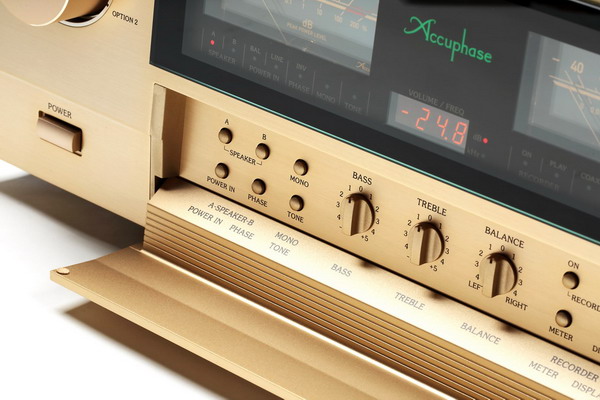
The E-470 is the Accuphase's integrated amplifier that I like most. It correlates with the way I understand sound and harmonizes with the way I experience it. The E-600, the top integrated amplifier manufactured by Accuphase, with an A-class power amp, is even better in a few aspects. I respect and admire this design. However, if I were to choose something for myself, for my own system, I would choose the E-470. In this way, I would make use of what I wrote about at the beginning—everyone must choose their own path and it does not have to be the "objectively" best one. It is enough if it is best for us.
The tested amplifier gives out thick, almost warm sound. Its tonal balance is a little moved towards the lower midrange and the mid bass has more energy than the rest of the band. The depth of sound and of the sound stage is excellent. Something is really happening here—there are no virtual movements, there is no deceit. We change the recording and instantly hear what has changed in performance. The situation is similar if we have different sessions recorded on the same album, like on The Jazz Keyboards of… which features recordings of four pianists from the pre-jazz era, that is from the years 1946, 1947 and 1953: Lennie Tristano, Joe Bushkin, Bobby Scott and Marian McPartland. The record, released in Japan by Savoy Records, is an excellent example of how good music, when carefully transferred, escapes the limitations of technology. Although the oldest recordings sounded the worst, they were full of meanings and music with Accuphase, and did mean something.
Also when it came to new recordings, the sound was "meaningful". The E-470 places its "seal" upon them all, by making them denser, richer, heavier. However, this is a structural modification—all recordings are modified in this way and it does not lead to sound standardization.
A side effect of this is more pleasant perception of records in which either all the sound or particular tracks are highly compressed. An example of this might be two records: X by Ed Sheeran and the debut of Royal Blood band, reviewed last month in the editorial: "Q" & "Classic Rock": verification.
When it comes to both the albums, the vocals are well in front and are characterized by clearly overdriven sibilance (i.e. they often "hiss"). The E-470 does not withdraw the treble, but renders it in a slightly sweet way, as if making the attack a little rounded. Therefore, its energy is high and I did not miss anything in it. What is more, the weaknesses of the recordings are not clearly shown. The amplifier presents the sound stage in an excellent, vivid way and when (as in the opening track of the Royal Blood album: Out Of The Black) the guitar (or rather the guitar amplifier) is placed quite far at the back, it is shown anyway. However, it is neither reduced, nor made flatter. It is simply possible to hear that it is still there.
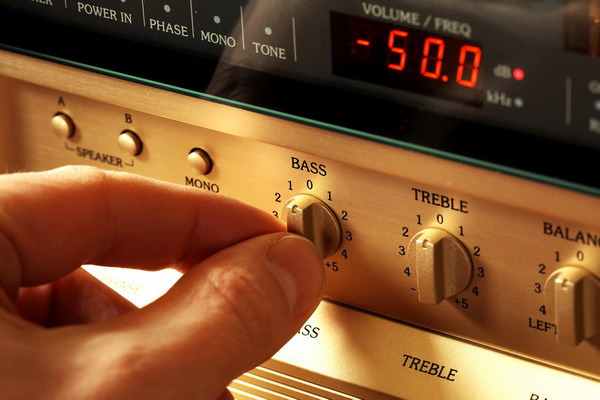
It was similar with Ed – the vocal is presented very close to us, but without being imposed. It was good. A very good dynamics of the device proves useful. It is delivered "casually", underneath, beneath the music and it never attracts the listener's attention, but it simply does its job.
I have just analyzed a few features of the E-470 sound. However, while listening to music produced by the Accuphase device, we are not induced to analyze sound. It is not the case. The differences in recordings, acoustics, timbre and production are immediately audible, but they are clearly something that is connected with music itself, something that constitutes part of a bigger package—the recording. However, it can also be heard, right from the beginning, that there is a lot of bass which is well-controlled and that the amplifier never lacks power. Low sounds are rather velvety than contoured, which makes the amplifier different from the E-600 which provided a definition of each sound more clearly. However, it must be said only if the room is not too big and the columns are too "difficult". Higher power of the E-470 makes it a more universal device. In a specially selected system, the E-600 will produce bass a bit more clearly, in a more selective way.
The E-470 also better shows the sequence of low based sounds, the way they are connected with one another. In both cases, however, it is hard to talk about bass as such, as it constitutes an integral part of the rest of the band. If I were to choose a device whose integration I like more, that would be the E-470. If it is necessary, I do not regret sacrificing selectivity in the name of coherence. If we want to have both, we have to use two-piece designs, perhaps even the A-70 power amplifier.
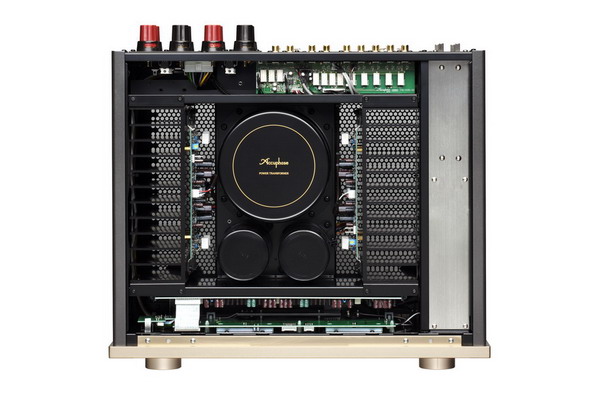
Summary
I would proudly place the E-470 in our editorial reference system No. 2, with the Graham Audio LS5/9 columns, Siltech cables and an analog turntable as the main source. The amplifier has many advantages, the most important of which is that it presents music in a pleasant, natural way, not forgetting about differentiation. The E-470 can become part of any system in which fluidity, musicality and density are most important. It has enough power to sound equally well in large rooms and with difficult columns, which is not so possible in the case of the E-600—power is power. It is a beautiful example of how mechanical engineering and electronics can be combined with the sense of music.
The DC-37 digital to analog converter is characterized by the same level of craftsmanship. The DAC manufactured by Accuphase works best with high-resolution files, especially transferred through the USB port. When the DC-37 is matched with a good-quality music player such as Arender X100L or Auralic Aries, they constitute an exceptionally pleasant system that can be further expanded in the future by adding Accuphase transport to play music from CDs and SACDs using the HS-LINK.
DESIGN
Anyone who has seen Accuphase equipment at my home—either the devices described above, or any other ones in the past—sighed with respect, even if the person in question was fascinated with tube amplifiers, especially home-made ones, produced on an ironing board. It is because all the elements in the E-470 and DC-37 design are perfectly made and fitted.
Both the devices have a similar mechanical construction. It is an advanced structure which consists of a few-layered chassis mounted to a rigid inner frame which divides the inside into functional "cells". The external panels, which are trimmed in the DC-37 with wood-like veneer, are made of aluminum.
E-470
The device looks like a classic example of integrated amplifiers manufactured by Accuphase, launched in the 21st century. The front panel comes in a golden champagne color and luminous header output power indicators are placed in the centre under a glass plate. In fact, these are VU-meters indicating the degree to which the power amp is controlled—the will still operate even when we disconnect speaker cables. Sound volume level is indicated with a notch on the right side of the knob, but it is also shown more transparently using an amber alphanumerical display with LED modules (it has been scaled in dB). If an optional digital-to-analog converter DAC-40 board is inserted into the device, then there will be displayed digital signal sampling frequency.
Other colors have been used to display the company logo (green) and for diodes connected with different types of buttons—speaker output activation, absolute phase change, tone control activation, the monophonic mode and direct power amplifier input (marked red). There are discreet red LEDs next to the input selector knob. Under a sub panel at the bottom there are a lot of additional function buttons and controls. It is where we select the type of cartridge if we have installed the optional DA-30 phono stage, or change the tone and balance. There are really plenty of such options.
It is a device characterized by exceptionally good functionality. That is why there are so many inputs and outputs in it. There are five line inputs and an additional input with a loop for recording, as well as a power amp input and a preamplifier output. All of them are unbalanced, based on RCA sockets. However, at the bottom there is a section with balanced connectors—two line inputs (HOT=3), a power amplifier input and a preamplifier output. Next to the power amplifier input there is a switch which can be used to change the absolute phase. Accuphase is representative of a constantly shrinking group of manufacturers whose XLR inputs are consistently cabled according to the "American" model which has also been adapted in Japan, where the "hot" pin is "3", not "2". We can now change this ourselves. It must also be added that the speaker output terminals are exceptionally large and handy. If we like bi-wiring, the thing is simple – we get two pairs of clamps per channel.
The inside demonstrates the capabilities of Japanese engineers. The device has been divided into functional modules with the use of screens. Additionally, a large shielded toroidal transformer with a few secondary windings is placed at the centre, alongside two large voltage-filtering capacitors. At the back there is a panel with
input connectors switched by relays, as well as an output protection circuit assembly. Right behind them there are integrated circuit input buffers operating in the MCS system, i.e. with a few parallel routes whose outputs are connected. Instead of relays, MOS-FET transistors are used in it. The Accuphase company puts a lot of emphasis on that, claiming that, as a result, noise has been reduced and the lifetime of the device has been extended.
At the front, behind the front panel, there is AVAA volume control. It is a special system which converts voltage signal into current, regulated signal and the other way round: converted signal into voltage signal. This results in very low noise and almost invariable input and output impedance, independent of the current rate of damping.
Power amplifiers are directly mounted to solid, cast heat sinks on both sides of the power supply. In the power amp there are three pairs of AB class Toshiba J613+K3497 MOS-FET transistors in a push-pull configuration. The whole arrangement is discreet, surface-assembled and controlled by bipolar transistors.
It is characteristic for Accuphase not to use any sophisticated, rare components. Instead, the company very carefully selects the elements, so that they comply with the defined parameters.
The amplifier is controlled using the remote commander RC-220 which looks as if it was made in the 1970s, but is actually very convenient and ergonomic. The buttons have distinct trip points and various shapes, and prove to be very useful.
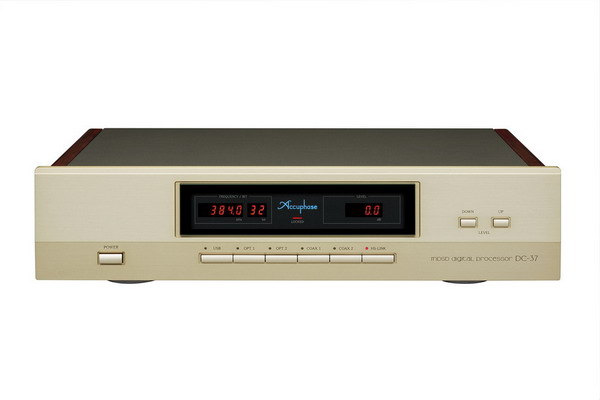
DC-37
The DAC is equally robust. There are handy input selector buttons in the front panel, as well as three displays: a sampling frequency display, a quantization bit level display and an output level display. Output level is changed using two buttons. A large, oblong diode indicates whether the device has been synchronized with the input signal. There are six inputs: 1 x USB, 2 x RCA, 2 x TOSLINK, 1 x HS-LINK. The first and the last one transfer signal to 32-bit and 384kHz, as well as DSD128, the co-axial ones to 24/192, whereas the optical ones—to 24/96. There are both balanced and unbalanced outputs. Next to the balanced ones there is an output phase selector switch.
The digital section is based on the Bravo SA9227 USB receiver and a Xilinx chip. Digital filters and support chips are placed in the latter, including MDSD for DSD signal. Thanks to this, there are no filters in the path when signal of this type is reproduced. Digital-to-analog conversion is carried out by two eight-channel ESS ES9018S chips, one per channel (L and R). Their outputs are controlled by a multiplied MDS++ circuit whose outputs are connected, thanks to which distortion decreases. There are separate balanced and unbalanced sections. Integrated circuits operate in the path. At the front there is a power supply with separate transformers for the "processor" section and the DAC itself.
Technical specifications (according to the manufacturer)
Output power:
• 260 W/4 Ω
• 220 W/6 Ω
• 180 W/8 Ω
THD (Total Harmonic Distortion) (both channels in operation, 20Hz – 20kHz):
• 0.05%/2 Ω
Intermodulation distortion (IMD): 0.01%
Frequency response:
• line input: 20Hz – 20kHz/0, 0.5 dB
• POWER IN input: 20Hz – 20kHz/0, 0.2dB | 3Hz – 150kHz/0, -3dB
Damping factor: 500 (8 Ω/50 Hz)
Input sensitivity
• unbalanced line input – 190 mV/20 kΩ
• balanced line input – 190 mV/40 kΩ
• POWER IN input – 1.51 V/20 kΩ
Gain:
• RCA input – PRE OUT output: 18dB
• POWER IN input – output: 28dB
Tone control:
• bass: 300Hz/± 10dB (50Hz)
• treble: 3kHz/± 10dB (20kHz)
Loudness: +6dB (100Hz)
Damping: -20dB
S/N ratio:
• RCA input: 109dB
• XLR input: 102dB
• POWER IN input: 125dB
Headphone impedance: 8 Ω and more
Power consumption:
• 92 W (without input signal)
• 611 W (full power/8 Ω)
Dimensions: 465 x 181 x 428 mm
Weight: 24.5 kg
Price (in Poland):
E-470: 32 900 PLN | DC-37: 34 900 PLN
Contact details:
ACCUPHASE LABORATORY, Inc.
2-14-10 Shin-ishikawa
Aoba-ku Yokohama | 225-8508 | Japan
Phone: +81-45-901-2771
www.accuphase.com
www.accuphase.pl
MADE IN JAPAN
Images by Wojciech Pacuła | Accuphase










